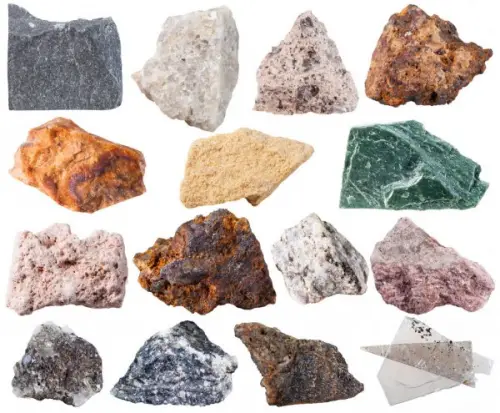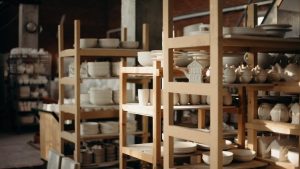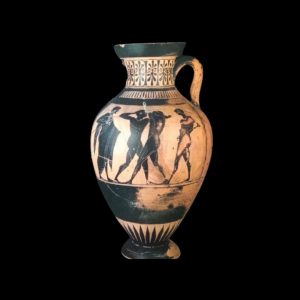Translated by Nick R
The word temper may sound out of place when talking about ceramics, and that should create a lot of questions within you.
But, don’t worry! Today we will explain everything you need to know about tempering agents, what they are, their types and uses, and more.
And without further ado, let’s get started.
Table of Contents
What are tempers?
Tempers are materials added to the clay so that it does not have excessive plasticity, a feature that may cause the clay to deform during all the processes to which it will be subjected, such as firing, for example, which is where a very plastic clay will break easily.
Typically, tempers are used on clay materials like earthenware, ball clay, and terracotta.
The tempers enable clay objects to become more resistant and easier to handle. Also, by enhancing clay with them, pieces do not break due to temperature changes, and the retraction during drying improves; they keep the original shape you modeled without deforming.
Brief history
Before revealing the existing types of tempering agents, you must know a little about their history. Here we go!
Just as pottery originated in the Neolithic period, so did tempers to complement the clay used by our ancestors. Formerly, people used tempers and water to make their pottery more resistant and prevent cracking during firing.
The tempering agents were and still are, obtained from nature and include sand, rocks, precious stones, dung, charcoal, straw, volcanic rocks, crushed shells, calcite, bones, etc.
These were ground or crushed and mixed with mud and water once in powder form. This way, they would begin to knead and form all their pieces.
Findings and developments
The first findings of pieces with some sort of temper were in Arene Candide, an archaeological site situated in Finale Ligure, Italy.
Through the analysis of the pieces, composed of thick-walled vessels, it was determined that they belong to the Ancient Neolithic period. These pieces are representative of the presence of the first farming and cattle-raising groups in the area. Furthermore, it was found that the tempering agents used by these groups in pottery manufacturing were chamotte and crushed calcite.
The following discoveries were made in Fontdes-Pigeons, France. There, ceramic remains were found that, like the above, belonged to the Ancient Neolithic period. However, thanks to studies performed on these remains, it was possible to identify three advances regarding the use and quantity of tempering agents for that period and in that civilization.
It was found that a considerable amount of chamotte and some bone were added to the first piece. In the next one, rests of chamotte and calcite were found in a balanced quantity. Finally, in the third one, there were only small traces of crushed calcite.
The last findings were made in the cave of San Sadurní in Barcelona, Spain. Same as in the pieces from France, only traces of chamotte were found. Less quantity of chamotte is found in some items but no traces of other tempering agents.
Other findings were in the Bauma del Serrat del Pont, Girona, Spain. The discoveries there were surprising, as their analysis showed that no tempering agents were employed.
Thus, it became evident that, while manufacturing their pieces and experimenting with tempers of different varieties and quantities, ancestors figured out the best way to make this process easier and faster. They even chose the best and most resistant temper for each type of piece, ranking chamotte in the first place, followed by calcite. An incredible advance, don’t you think?
What types of tempers are used in artisanal ceramics?
As we mentioned earlier, many types of tempers have been used since the dawn of this ancestral practice; however, today, we will talk about the 5 most known and used from the past to the present day. Namely, chamotte, quartz, sand, silica, and feldspars.
Chamotte
Chamotte, also known as grog, is clay coming from stones and calcinated, crushed, or ground. It is added to highly plastic clays to give them greater resistance.
It should be noted that, according to the used amount, chamotte produces a rough and rugged texture to the clay. Also, be aware that this texture is transferred to the burnt glazes; after the piece has been burnt, it will keep some of this texture.
How to use chamotte as a temper?
Next, we show you how to use chamotte to mix it with plastic clays.
Step 1: Chamotte is usually found in stone form; therefore, the first thing to do is to grind these stones until they are almost a powder.
Step 2: Keep this powder in a pot or container.
Step 3: Pass the chamotte powder through a sieve or strainer. It will help you obtain a thinner powder, which is what you will use for your clay. Make sure to place another container underneath where the powder will fall into.
Step 4: Once you have your chamotte powder ready, apply the amount you consider necessary to the clay or mud and water mixture.
Remember that the more you add, the stronger your piece will be; however, if you overdo it, you will not be able to handle it very well. Thus, always add chamotte based on the piece’s size.
However, we recommend applying a 10% or 20% maximum.
Step 5: knead the mixture until it has a not too liquid but soft texture, and when you identify this point, your clay will be ready to start modeling your figure.
Quartz
Quartz mineral is found in the form of precious stones or rocks given their characteristic white transparent color, much like a diamond, yet it has also sometimes flashes of red, green, violet, and blue.
Normally, quartz can be found in most soils, rivers, and roads in nature as it occurs on any earth’s surface, no matter the temperature.
Quartz is also known as silica, which comes in two forms: α-quartz and β-quartz. But how are they different? It is actually not too complicated.
Also known as low quartz, quartz-α is found in temperatures up to 573 °C and has a trigonal structure. Meanwhile, quartz-β is found in temperatures up to 867 °C and is hexagonal. Do not be distressed, both forms of quartz can be used in the same way.
Like chamotte, quartz is used to enhance the strength and toughness of clays with high plasticity. Also, the amount to be applied depends on the size of the piece.
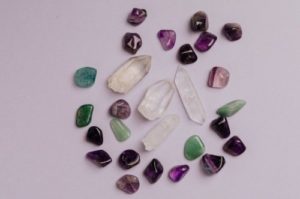
How to use quartz as a temper?
Step 1: Like chamotte, quartz, or silica can be found in the form of shiny stones. Using a large, hard rock, start crushing the quartz in a container or pan until it becomes a powder.
Step 2: Once the quartz is finely crushed, pass it through a strainer and collect it in another container underneath to separate it from the one you are straining.
Step 3: Add the amount of powder you consider necessary to your clay with water. Do not exceed the quantity; we advise you to apply 10% or 20% to your mixture.
At this point, you should keep in mind that tempers have different shades, as is the case of silica, which can be found in different colors, as mentioned before.
So if you are using white clay and do not want it to change its color, use a white or light-colored temper.
Step 4: Start kneading until the clay is ready to be handled, and you can start making your pieces.
Sand
Sand is a temper easy to get and use. First, know that you can use any type of sand, from coarse to fine. It is perfect if you live near a beach and you can take some.
And as we already told you, sand is also used to strengthen the clay you will use to make your pieces.
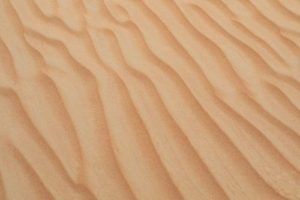
How to use sand as a temper?
Using sand as a temper is really easy, much more than the process of the tempering agents we already mentioned, so here are the steps to follow.
Step 1: Collect your sand in a container, and remember it can be of any type. However, if the sand is wet, you should dry it completely on a plastic sheet in the sun.
Step 2: Once the sand is dry, strain it with a sieve or strainer. Always have another container underneath to catch the purer sand that falls from the sieve.
Step 3: Add 10% or 20% of sand to your clay-water mixture of at least 1 kg. These percentages correspond to a small spoon. Keep in mind that your temper must be fine-grained so as to mix with the dough.
Step 4: Thoroughly knead until you create a uniform but not too liquid dough that is easy to handle.
Step 5: Once the clay is ready, you can start creating your artwork.
Calcite
Calcite is a sedimentary mineral composed of calcium and thus is widely used in the construction industry since its properties provide the pieces with the necessary resistance.
This material is also used to manufacture metals, paints, rubbers, glass, fertilizers, and, of course, in the artisanal ceramics field.
Calcite temper can be found in nature in the form of rocks characterized by their bright white color, although it is also available in colors such as orange, blue, green, and yellow.
What differentiates it from quartz is that calcite is mainly found in geological sedimentary deposits, which are basically mountains made of stones rather than earth.
Like all the above, calcite has been a very popular temper from its beginnings to the present day.
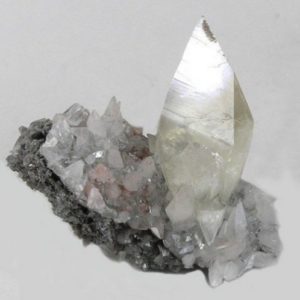
How to use calcite as a temper?
The process for using calcite as a temper is the same as with quartz and chamotte, as it comes in the form of a stone too. Therefore, you must follow the same steps.
Important: remember that colored calcite can change the tone of your clay, so use white calcite if you don’t want that to happen. However, feel free to play with the colors if you wish.
Feldspars
Feldspar is a mineral composed of aluminum and silicon. The latter, being the second most abundant material on earth after oxygen. It is characterized by being the main component of the earth’s crust.
Feldspar can be found in nature as 60% of the earth’s rocks contain high degrees of this material. Terrific!
Nowadays, this material is used for manufacturing glass, porcelain, and ceramics due to its resistance. Feldspars are found in stones that can be easily turned into dust, and they can be white, grey, green, brown, yellow, red, and black.
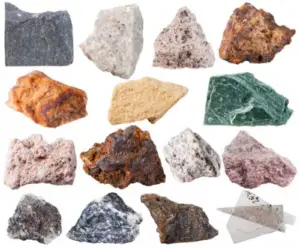
How to use feldspars as tempers?
To use feldspars as tempers, you must follow the same steps that we explained with chamotte and quartz since the process is the same. Super easy!
Advantages and disadvantages of tempers
Here are some advantages and disadvantages of using tempers on ceramics.
| Pros | Cons |
| ∙ Tempers increase the strength of your pieces during firing. ∙ Tempers complement plastic clays (terracotta, earthenware, or ball clay) to make them easier to handle. ∙ Thanks to their color variety, they can be used to change the color of the pieces at will. ∙ It is not mandatory to use them on more plastic clays. As a potter, you can choose whether to use them or not. ∙ Some tempers can add textures to the clay. If you want to play with textures, these are good allies. | ∙ Some tempers are not easy to obtain or differentiate. ∙ If you do not have enough knowledge on this subject and apply any temper, it can change the color of the clay. ∙ For some, it is difficult to handle the clay with tempers’ residues because it can hurt their skin. ∙ The grinding, straining, and mixing process can take some time. ∙ Some tempers can add textures to the clay, and thus may be retained in the final piece and affect the result. |
Where to buy ceramic tempers?
If you want to apply some temper to your clay, but you feel it is too difficult to get some type of temper on your own, we have good news!
Let us tell you that you can get these tempers already prepared to be applied to your clay in specialized stores. Or if you like to do your shopping online, you can buy them there too.
____________________________________________________________________
We end this blog with this recommendation. Remember that the use of these tempers is not compulsory, so use them only when you see that your clay is too plastic and cannot be well handled or if the pieces break while baking in the kiln.
We hope you liked this article and that, above all, you have learned about this important topic in the world of ceramics, yet so unknown by many.

